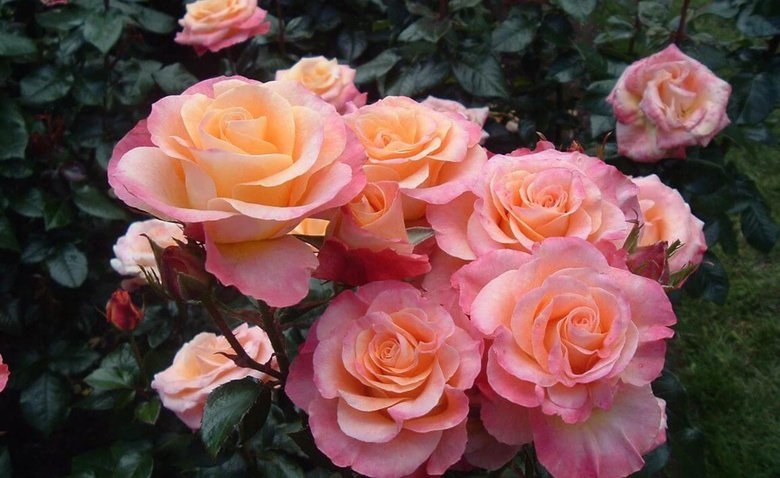Content:
Many varieties of roses grow not only in spring but also outdoors in winter. They can be planted after proper soil cultivation with special means. For roses to bloom profusely, you need to plant them outdoors in a place where they will be somewhat protected from the sun, wind and sudden temperature changes (in the garage or temporarily moved to a closed place, if possible).
General rules for caring for roses at home and in the open field
Typically, most plants require a minimum of 5 hours of sun per day, despite the growing season. Before planting a rose in your garden, you need to choose the right type of plant. For example, they sell roses that are suitable for places that receive only the morning sun.
The reason why roses bloom poorly in the country is the improper care of the decorative culture. With good care, roses grow long shoots during the summer period, up to 2-3.5 m.
Among the basic rules for care are:
- Proper watering of the plant. It is better to use a watering can, directing it under the bush. This should be done differently depending on the season. In the spring, you need to ensure constant watering as the soil dries out, but at least 1 time per week. In the summer - 2 times a month, if there is a drought, then you need to increase it up to 2 times a week. In August and September, watering is rarely done so that new shoots do not appear, which can freeze in winter. The last watering of the year must be carried out 2 weeks before frost, after which the plants spud.
- Top dressing. For this, nitrogen fertilizers are used, containing phosphorus, potassium. Organic and mineral fertilizers are applied by foliar feeding.
- In the spring, a certain number of frozen and podoprevshie shoots that survived after winter are first spread on the ground so that strong replacement shoots develop at the base of the bush, which ensure the flowering of the bush for the next year. When young shoots of replacement reach 50-70 cm in length, the old ones (they will bloom after wintering) are tied to supports. Further pruning of climbing roses will depend on whether they bloom once or several times. If the rose belongs to re-flowering, then branches of different orders from 2 to 5 are formed on the main shoots within 3 years, their flowering weakens by the fifth year. Therefore, the main shoots are cut completely after the fourth year. If many new and strong shoots form at the base of such shoots, then the main ones are cut out, like in the first group. Extending the flowering of a rose is possible if the branch and leaf are cut in early spring. Thus, you can increase the flowering period of an ornamental culture.
How many times do roses bloom in summer
An equally relevant topic among gardeners is how many times roses bloom over the summer. If, after flowering, cut off the buds along with the branches, leaving several buds on the bush (of which leaves will appear), over the summer the rose can bloom 2-3 times. In addition, good air circulation is important for roses, they will bloom if the gardener can isolate the plants from other bushes or flowers.
What to do if roses bloom quickly in the garden and at home
To understand why roses quickly fade in the garden, you need to evaluate agricultural technology. If a grower plants a rose in the same spot where this flower was removed, then the plant will bloom late and slowly. Experts say that in this case it is necessary to replace the soil with another. Basically, the rose begins to bloom in April.
The duration of flowering also depends on the type of plant. For example, modern hybrid tea flowers need a mild climate, more care, and extra protection to survive in adverse conditions. There is also a hardy shrub type that is ready to bloom both in summer and winter.
How to prolong the blooming of roses in the garden or at home:
- Classic rose petals need to be fed, otherwise they may fade.
- Water in a timely manner.
- Provide adequate air humidity.
- Protect from pests (spray). It should be borne in mind that some varieties are more resistant to insect pests and diseases.
- The main pruning is done during the winter rest of the plant. On strong main shoots, 5 buds are left, and on small ones - 2 or 3 (or not at all). It depends on the desired size of the bush. The more shoots it has, the fewer the flowers will be. In the summer, a homemade rose is cut regularly.
- It is necessary to immediately remove the faded bud, which takes away the strength of the plant, shades it and provokes the development of fungal diseases. Do not forget about dried leaves, which must be removed in a timely manner.
How to prolong the flowering of roses: expert advice
For those who are worried about the question of why roses bloom so quickly, expert advice will be useful:
- The first rule is to always remove faded buds on time. But this is just a rule of basic plant care, and there are ways to prolong the flowering of roses differently.
- If hybrid tea species grow in the house, then this can be done using autumn pruning, or rather, its intensity. For example, if three rose bushes of different colors grow side by side, then in the fall they need to be cut in this way: the first is shortened to a level of 5-8 cm, the second to 10-15 cm, and the third to 20 cm. As a result of such an unequal pruning, the first the bush will give short shoots, and they will delight with flowers before anyone else. The rapid growth of the bush occurs one and a half weeks later, and the last one even later.
Caring for a rose is a difficult job that requires experience and knowledge. But the beauty of this flower and the ability to prolong flowering compensate for all the energy spent on its development. This is a real decoration for every home and garden!














